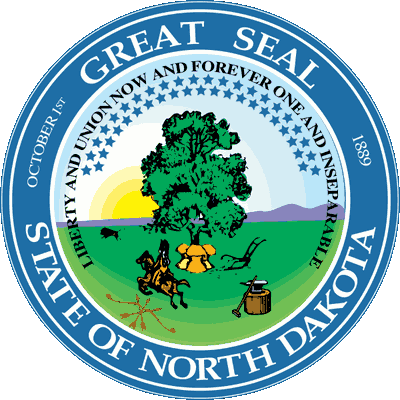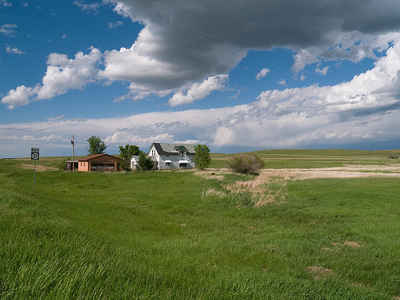- » 50 States
- » Histories
- » State Symbols
- » Seals
North Dakota State Seal
Great Seal of the State of North Dakota

Adopted in 1889.
The North Dakota Great Seal was adopted in 1889.
From the time of its ratification in 1889, North Dakota's Constitution has always contained the same detailed description of the state's Great Seal. Now found in Section two of Article XI (titled General Provisions), the description of the Great Seal was initially located in Section two of Article XVII (titled Miscellaneous) in the 1889 version of the Constitution.North Dakota Great Seal
Some of the wording contained in the Constitution's description is the same as that used for the territorial seal approved on January 3, 1863, by the Legislative Assembly of the Territory of Dakota.The description reads as follows:
A tree in the open field, the trunk of which is surrounded by three bundles of wheat; on the right a plow, anvil and sledge; on the left, a bow crossed with three arrows, and an Indian on horseback pursuing a buffalo toward the setting sun; the foliage of the tree arched by a half circle of forty-two stars, surrounded by the motto "Liberty and Union Now and Forever, One and Inseparable"; the words "Great Seal" at the top; the words "State of North Dakota" at the bottom; "October 1st" on the left and "1889" on the right.
The October 1 date was the day the voters approved the state's constitution by a vote of 27,441 (77%) to 8,107 (23%). Research has failed to reveal the reasons the selected symbols were chosen. As a result, various theories have been advanced over the years. For example, the tree has been identified as an American Elm. However, the American Elm was not adopted as the state's official tree until 1947. The three bundles of wheat could represent the three branches of government - executive, legislative, and judicial. The plow, anvil, and the sledge may make reference to the agricultural background of the state and to its strong work ethic. The bow and arrows, buffalo, the Indian on horseback, and the setting sun could be reminders of an integral segment in the history of the northern plains. The motto is a quote by Daniel Webster.
Although North Dakota became the thirty-ninth state, the seal has forty-two stars across the top. Since it was not known at statehood as to which "number" North Dakota would be, it's assumed the stars represent the forty-two states which would comprise the Union by the end of 1889.
While the content has generally been true to the description, the design of the Great Seal itself has varied through the years. The first known design is found in the 1887 Blue Book. There were designs with slight variations from its predecessor in at least 1899, 1907, 1909, 1911, 1913, 1919, 1926, 1929, 1973, and 1987. In the spring of 1987, then Secretary of State Ben Meier commissioned Dickinson artist Lili Stewart-Wheeler to create a new design. That design was approved on September 17, 1987, and is the same one used today.
Since statehood, the Secretary of State has been charged with the custody of the Great Seal. The first legislation related to the Great Seal was passed by the First Legislative Assembly in 1890 (Senate Bill 23). Nevertheless, relatively few changes in the law were made through the years. A major change was made in 1975 which prohibited the use of the Great Seal in advertising and for commercial purposes. An exception was passed in 1985 (effective until June 30, 1991) allowing the use of the Great Seal for approved commercial purposes as a part of North Dakota's Centennial Celebration. Otherwise, for many years the use of the Great Seal was largely dependent on numerous opinions issued by the Attorney General.
To more clearly define the acceptable uses of the Great Seal and to end the dependency on the opinions, S.B. 2448 was passed by the 1995 Legislative Assembly. The bill gave the Secretary of State greater flexibility and authority in carrying out the custodial responsibilities related to the Great Seal. In addition, it specifically prohibited the use of the Great Seal for political purposes. The existing law was also amended to allow the Great Seal to be reproduced, with the concurrence of the Secretary of State, on items offered for sale as gifts and souvenirs by the State Historical Society and the Parks and Recreation Department. The 1997 Legislative Assembly authorized the Great Seal on business cards for state employees. (S.B.No. 2150)
North Dakota Century Code
TITLE 54 STATE GOVERNMENT.
CHAPTER 54-02 STATE EMBLEMS, SYMBOLS, AND AWARDS
SECTION 54-02-01
54-02-01. Great seal - Permitted uses - Penalty for commercial use.
1. The great seal of the state is that prescribed in section 2 of article XI of the Constitution of North Dakota. A description in writing of such
seal must be deposited and recorded in the office of the secretary of state and must remain a public record. A reproduction of the great seal may be
placed on any official form, document, or stationery of any agency, authority, board, body, branch, bureau, commission, committee, council, department,
division, industry, institution, or instrumentality of the state or of any elected or appointed official of the state. A reproduction of the great
seal may be placed on business calling cards produced for the use of an elected or appointed state official or state employee regardless of whether
the cards are purchased by the official or employee or by the state. Any use of the great seal on any other object or thing by any of the foregoing
state entities or officials is prohibited unless approved by the secretary of state; provided, however, that the state historical society and the parks
and recreation department may, with the concurrence of the secretary of state, reproduce the great seal on any objects they offer for sale as souvenirs.
2. It is a class B misdemeanor for any person to:
a. Place or cause to be placed the great seal, or any reproduction of the great seal, on any political badge, button, insignia, pamphlet, folder,
display card, sign, poster, billboard, or on any other public advertisement, or to otherwise use the great seal for any political purpose, as defined
in section 16.1-10-02.
b. Place or cause to be placed on the great seal, or any reproduction thereof, any advertisement.
c. Expose the great seal, or any reproduction thereof, to public view with any advertisement attached thereto.
d. Utilize the great seal, or a copy or reproduction thereof, for any commercial purpose or except as provided in subsection
1, to utilize or place a copy or reproduction of the great seal on any stationery or business calling card of any person.
As used in this subsection, "advertisement" means any printed matter, device, picture, or symbol, no matter how presented
to the senses, which informs the public that a good or service is available; and "commercial purpose" means with intent to produce a pecuniary
gain through sale of a good or service. Notwithstanding any other provision of law, the secretary of state may grant a written request by a private
vendor to reproduce official state forms and documents, containing a reproduction of the great seal, for resale to persons intending to submit the
forms or documents to any state entity in the regular course of business. The secretary of state may also grant a written request by a publisher, educational
institution, or author to reproduce the great seal in any research, reference, or educational publication containing a compilation of the great seals
of other states.








